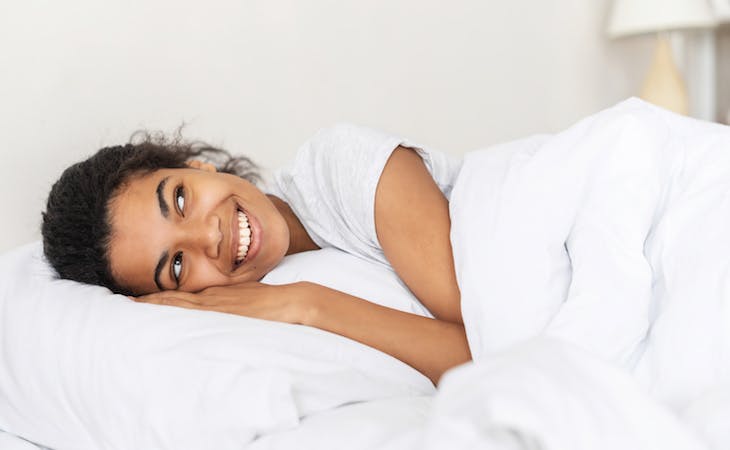Always get drowsy right as 10 p.m. rolls around? Never seem to be able to sleep past 6:45 a.m., even on a Saturday? It’s all likely due to your circadian rhythm. Here, a top sleep doctor explains how circadian rhythm works, how it affects your health, and what you can do to keep your circadian rhythm in tip-top shape.
What is a circadian rhythm?
The word circadian is based on two Latin words and roughly translates to “around the day.” Circadian rhythms are defined as a collection of processes in the body that follow a 24-hour schedule, explains neurologist Jeffrey Durmer, MD, PhD, a systems neuroscientist, board-certified sleep medicine physician, and co-founder of FusionHealth. Those can include physical as well as mental and behavioral changes. “A circadian rhythm matches what happens in your body to what’s going on outside,” says Durmer. These rhythms don’t just apply to humans either. Animals, plants, and even tiny microbes all exhibit circadian rhythms that shape their day.
How circadian rhythm works
Your circadian rhythm is guided by a “central conductor” in your brain that coordinates a variety of cycles and processes happening inside your body such as temperature, hormone levels, metabolism, and sleep across the 24-hour day, says Durmer. In humans and other vertebrate animals, this central conductor is called the suprachiasmatic nucleus, a group of about 20,000 nerve cells located inside the brain’s hypothalamus. While the central conductor controls the circadian rhythm, it can also be impacted by environmental stimulus—namely, light.
When it’s dark out, the central conductor signals your brain to produce more melatonin, a hormone that makes you drowsy. When light hits your optic nerves from morning sun—or a smartphone screen—your brain stops melatonin production, allowing you to wake up. This is why sleep experts recommend keeping your bedroom as dark as possible and suggest avoiding screen time before bed.
Circadian rhythm and sleep
Maintaining a consistent circadian rhythm can help to ensure you get a good night’s sleep. “Thanks to your circadian rhythm, you’re typically tired at the same time each night and ready to wake up at the same time each day,” Durmer says. “That’s why you should do your best to maintain regular wake times and bedtimes.” He explains that waking up around the same time each day helps to kick-start your internal synchronization, keeping you and your circadian rhythm in working in unison.
Related: The health risks of being a night owl
Circadian rhythm and health
While we generally associate circadian rhythms with sleep, your circadian rhythm impacts many aspects of your health, from body temperature and hormone release to mood, cell function, and more. “Circadian rhythms deal primarily with sleep and sleep cycles, but if they are upset, then impacts outside of sleep may occur,” explains Durmer.
There is research to support connections between circadian rhythms and asthma symptoms, allergies, metabolism, mood disorders, heart health, and even the effectiveness of chemotherapy. Many of the negative impacts come from being “out of sync” with your circadian rhythm.
Durmer explains that there are four categories of health risks when you’re out of sync with your circadian rhythm:
- metabolic disease (obesity, diabetes, metabolic syndrome, etc.)
- mental disease (mood disorders, anxiety disorders, bipolar disorders, etc.)
- cardiovascular disease (arrhythmia, atherosclerosis, hypertension, stroke, heart failure, etc.)
- immunological disease (autoimmune diseases, infectious disease, cancer)
Luckily, you can limit these health risks by working to maintain a healthy circadian rhythm.
How to maintain a healthy circadian rhythm
Use these tips to keep your circadian cycle in sync.
Discover your chronotype
“The first thing you need to do is pay attention to your natural rhythms,” says Durmer. While everyone has a circadian rhythm, your chronotype is your particular pattern of sleep and wake time during a 24-hour cycle. “Circadian rhythms, while generally built on the same foundation, vary from person to person because of age, genetic, and environmental differences,” explains Durmer. “Morning people like mornings better. Night people like nights better. Paying attention to our natural inclinations, also known as our individual chronotypes, allows us to incorporate the best practices from circadian rhythm research while also acknowledging that there’s no one-size-fits-all approach.”
Help your body wake up
If you struggle to roll out of bed in the morning, help jump-start your circadian rhythm by putting your body’s cue system to work. The National Sleep Foundation recommends starting the day by letting in lots of sunlight or even going for a morning walk. This will help signal your circadian rhythm that it’s time to start the wake cycle.
Cut down on nighttime light
While our bodies are designed to take cues from the morning sun that it’s time to wake up, experiencing bright light at night can have the same effect on our “central conductor,” making it harder to fall asleep. While the nighttime blue light from computers, tablets, and cellphones gets most of the bad rap, even overhead lights in the house, street lights outside of your window, and the glow from your alarm clock can all negatively impact your circadian rhythm.
Establish a routine
While sleeping in on the weekend to make up for missed shut-eye during the week may sounds tempting, waking up at the same time every day can help maintain a healthy circadian rhythm. Consistency is key, Durmer notes. That means going to bed and waking up at the same time (or within an hour of your normal time) seven days a week, even on the weekends. Boring, perhaps, but your circadian rhythm will reward you with better, more satisfying sleep.
Are you getting enough sleep? Take our sleep deprivation quiz to find out if you should be snoozing more, along with tips for getting better rest.








